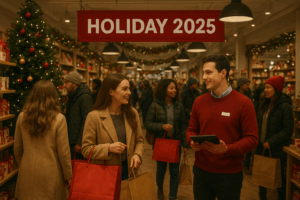Retail’s Holiday 2025: More Sales, Profits, And AI-Driven Commerce

Time to pull out the holiday decorations and start building that gift list — Q4 2025 is upon us! For retail and other business leaders, this means daily meetings to raise, review, revise, and rip apart their inventory, promotion, commerce, and marketing strategies. It also means a perennial flow of opinions and predictions until mid-December for how consumers and competitors will behave. But there are five things that history and data show you don’t have to waste time wondering about — facts that you can securely build your strategies upon. What should you expect for this holiday shopping season?
- Sales will be higher than last year. In the last 25 years, only twice has year-over-year holiday sales declined: during the Great Recession and the pandemic. This means you can ignore the consumer sentiment report, the studies that show consumers are more cautious, and the pundits who say the government is going to kill holiday demand. While 77% of consumers already expect prices to be up this holiday season, this kind of expectation in the past has never caused a decline in year-over-year consumer spending. So plan for your topline sales to be up as long as you have a strong brand, you’ve managed to maintain last year’s market position, and you’ve made smart assortment decisions.
- Profits will be up. If you’ve enjoyed slightly higher profit margins year-to-date, you can pretty much count on the same for Q4. There are a number of factors contributing to this. First, you’re doing more with less. At this point after the “great resignation” of 2023, it’s likely you’ve managed to figure out how to run your business with a leaner team. Some of you have compounded that by using AI to reduce payroll in management and operational roles. In addition, the inelastic nature of the consumer’s holiday shopping habits tends to make them pay up to pricing while maintaining their core gift counts. Finally, those that bought product early and at lower prices to avoid tariff impact risks will add another couple basis points to the bottom line.
- Promotions will be neutral until they take off in mid-November. Large retailers did something unexpected this year: They didn’t all begin promoting holiday sales with the start of Prime Big Deal Days (Oct. 7–8). In fact, only two brands out of 116 Forrester monitored had some sort of holiday messaging on their home pages. So why will things change in mid-November? Unfortunately, there is a downside to tariff fears driving retailers to make holiday purchases early: They commit to purchases without having the trend data to make surgical decisions. And in these situations, they tend to overbuy rather than risk a lot of out-of-stock situations. To add to this perfect storm, there are five fewer shopping days between Thanksgiving and Christmas this year. The result? Overstocked retailers will start getting nervous and apply some serious “promo motivation” to move products right around Black Friday weekend.
- AI will significantly impact consumer buying considerations. Nearly one in five US online adults stated that they plan to use AI to help them find gifts this year. That’s no surprise, as answer engines like Perplexity, ChatGPT, or Google Gemini naturally fit into the way consumers research gift ideas. For instance, a customer might chat with one of these “agents” to find a gift for someone who’s hard to shop for. In fact, I predict that “What is the perfect gift for … ?” will likely be one of the top 10 prompts for November. Forrester’s own research shows that consumers are rapidly getting comfortable with conversational search, and many are using it as part of their path to purchase. There may not be time to fully partner in the way that Walmart and OpenAI have, but retailers and brands need strategies for reaching consumers who have jumped ship from Google as “the” holiday search tool.
- Late-season shopping will be a big part of the story. In the last few years, shoppers have been starting and finishing their shopping later in the holiday season. This trend will continue for three reasons: First, retailers are still whispering about holiday in mid-October and not giving consumers many incentives to buy early. While that is right up there with the 54% who said this in 2008, the beginning of the Great Recession, it’s more of a belief than a fact. If it fails to play out, consumers will return to shopping but much later than when that number was trending lower (30% in 2024). Finally, consumers said so: According to NRF, only 42% of consumers stated they will be browsing or buying before November (the lowest percentage since 2020) and 60% don’t expect to be done until December. All told, this combination will cause more consumers to pause before hitting the buy button.
How Forrester Can Help
For a deeper dive into what to expect this holiday season, Forrester clients can schedule a guidance session with me.
In the meantime, please visit my profile page and click “Follow” to be notified whenever I publish research.
